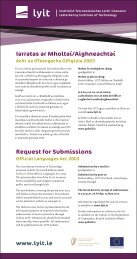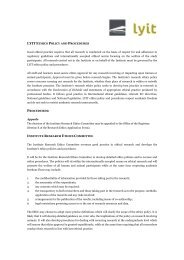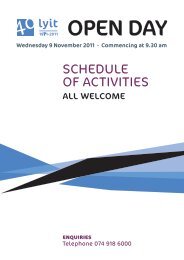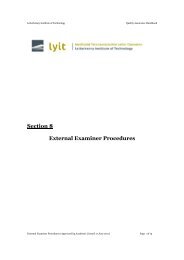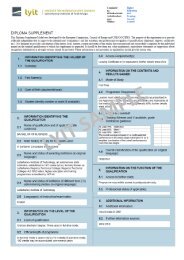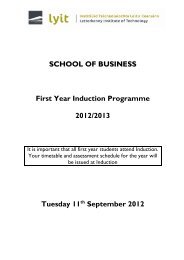Scoping Study Final Report.. - Letterkenny Institute of Technology
Scoping Study Final Report.. - Letterkenny Institute of Technology
Scoping Study Final Report.. - Letterkenny Institute of Technology
Create successful ePaper yourself
Turn your PDF publications into a flip-book with our unique Google optimized e-Paper software.
North West Gateway Strategic Alliance (NWGSA) <strong>Scoping</strong> <strong>Study</strong>Apart from tuition fee differences and the MaSN Cap, we do not believe that otherdifferences in the HE operating environments North and South are likely to impedeenhanced collaboration between LYIT and Ulster for the betterment <strong>of</strong> the NWGSARegion. Existing joint initiatives between LYIT and Ulster – notably the MSc inInnovation Management in the Public Services – clearly demonstrate how differencesin operating systems can be overcome (graduates from this novel programme gaindual accreditation, namely an MSc with the Ulster brand and RoI HETAC Level 9branding, which is both unique and attractive to students).7. Higher Education Operating Environment – Pr<strong>of</strong>iles <strong>of</strong> Ulster and LYITBoth LYIT and Ulster have experienced impressive expansion in recent years and thishas been an important input into the positive socio-economic developmentsoccurring in the NWGSA Region, including population growth, employment growthand the presence <strong>of</strong> a number <strong>of</strong> innovative enterprises in the Donegal and NI parts<strong>of</strong> the region. It is also important to recognise that the growth in student numbersachieved by Ulster and LYIT has come against a more difficult market environment –as stated earlier the number <strong>of</strong> residents aged between 15 and 24 years has declinedin certain parts <strong>of</strong> the region.Ulster is the largest provider <strong>of</strong> HE in NI – in fact in the island <strong>of</strong> Ireland – withapproximately 24,000 students in 2007/08. It is a significant contributor to theNWGSA Region: in 2007/08, Ulster’s Magee and Coleraine campuses togetheraccounted for over 9,000 full-time and part-time undergraduate and postgraduatestudents and both campuses currently employ in the region <strong>of</strong> 2,000 staff (headcountbasis) (almost 1,400 on full-time equivalent basis).Taking Ulster’s Magee and Coleraine campuses together, our analysis reveals thatpart-time undergraduate and postgraduate numbers have grown more rapidly thanfull-time undergraduate and postgraduate numbers in the NWGSA Region duringthe past decade. This trend reflects Ulster’s commitment to lifelong learning in theNWGSA Region and is further illustrated by the fact that part-time students as aproportion <strong>of</strong> all students has risen at Ulster’s Magee and Coleraine campuses during1997/98-2007/08.Magee and Coleraine together had over 7,600 undergraduate enrolments in 2007/08,making up almost 40% <strong>of</strong> Ulster’s total undergraduate population in that year. Keyfaculties at Magee and Coleraine are Life and Health Sciences (1,749 and 990undergraduate enrolments at Coleraine and Magee respectively in 2007/08), theUlster Business School (1,119 and 618 undergraduate enrolments at Coleraine andMagee respectively in 2007/08) and Arts (1,063 and 609 undergraduate enrolments atColeraine and Magee respectively in 2007/08). Also important at Magee are theFaculty <strong>of</strong> Social Sciences and the Faculty <strong>of</strong> Computing and Engineering – the latteraccounted for 619 undergraduate enrolments and the former for 579 such enrolmentsin 2007/08.Indecon and London Economics March 2009 Page 9



